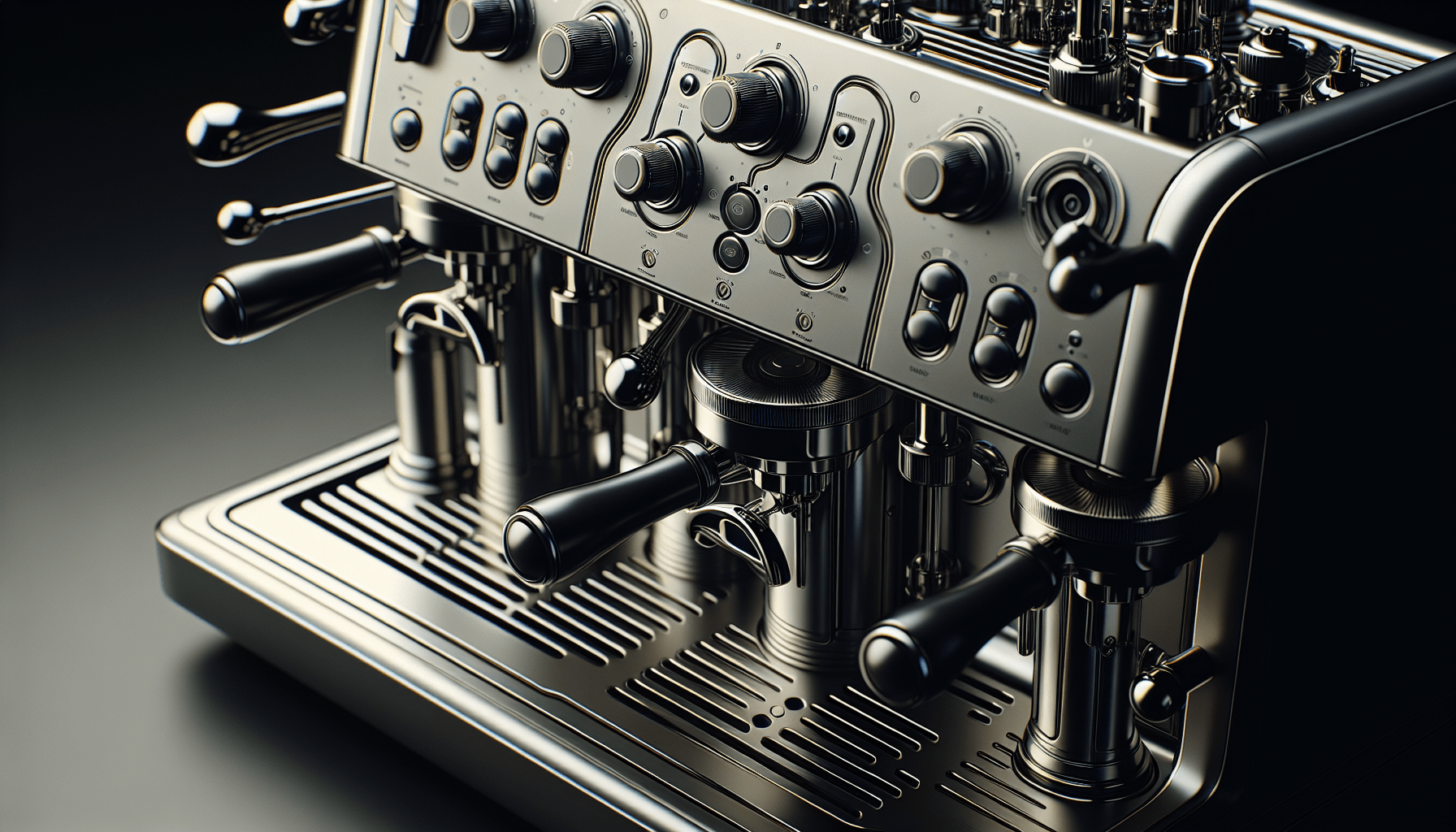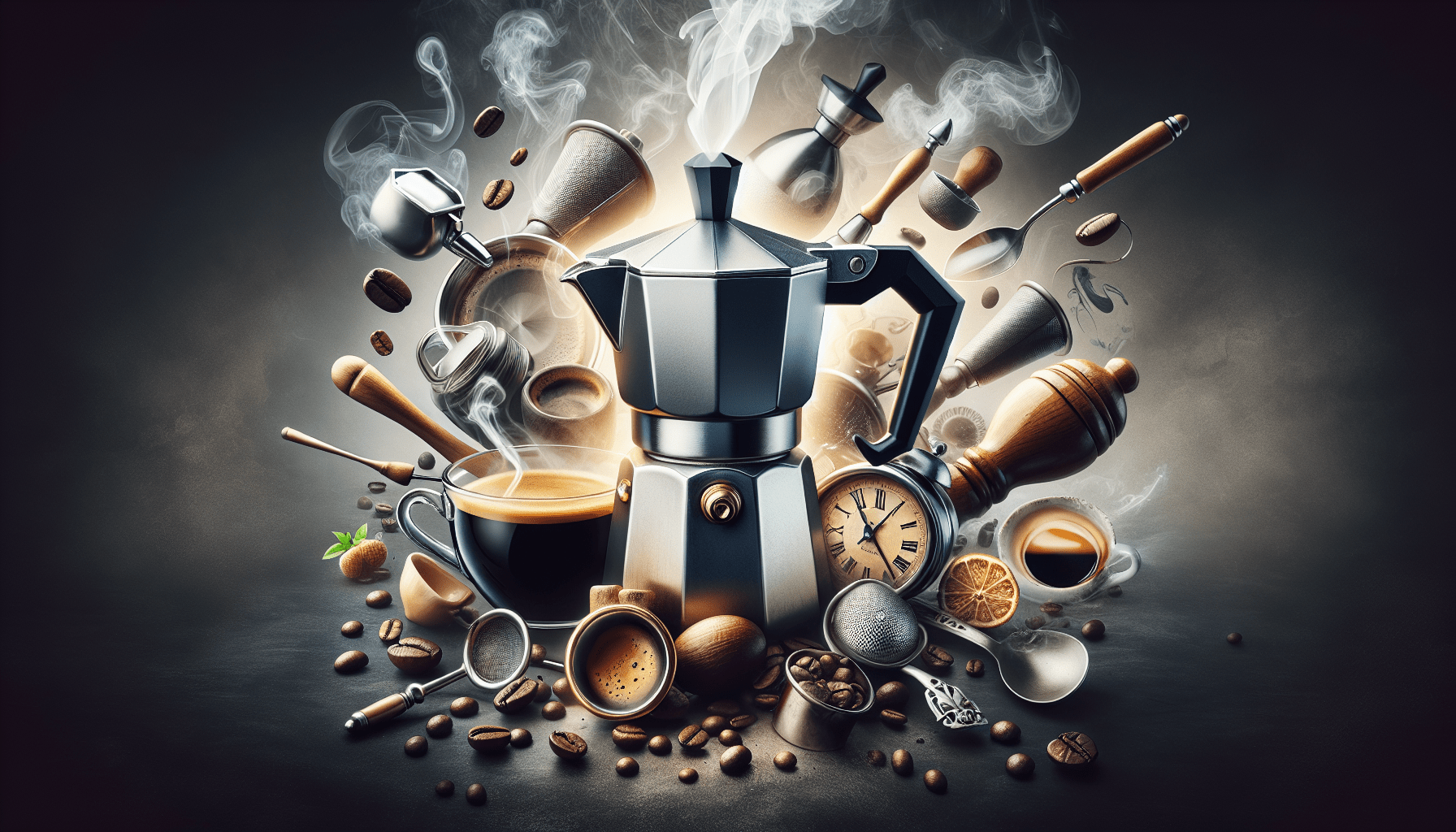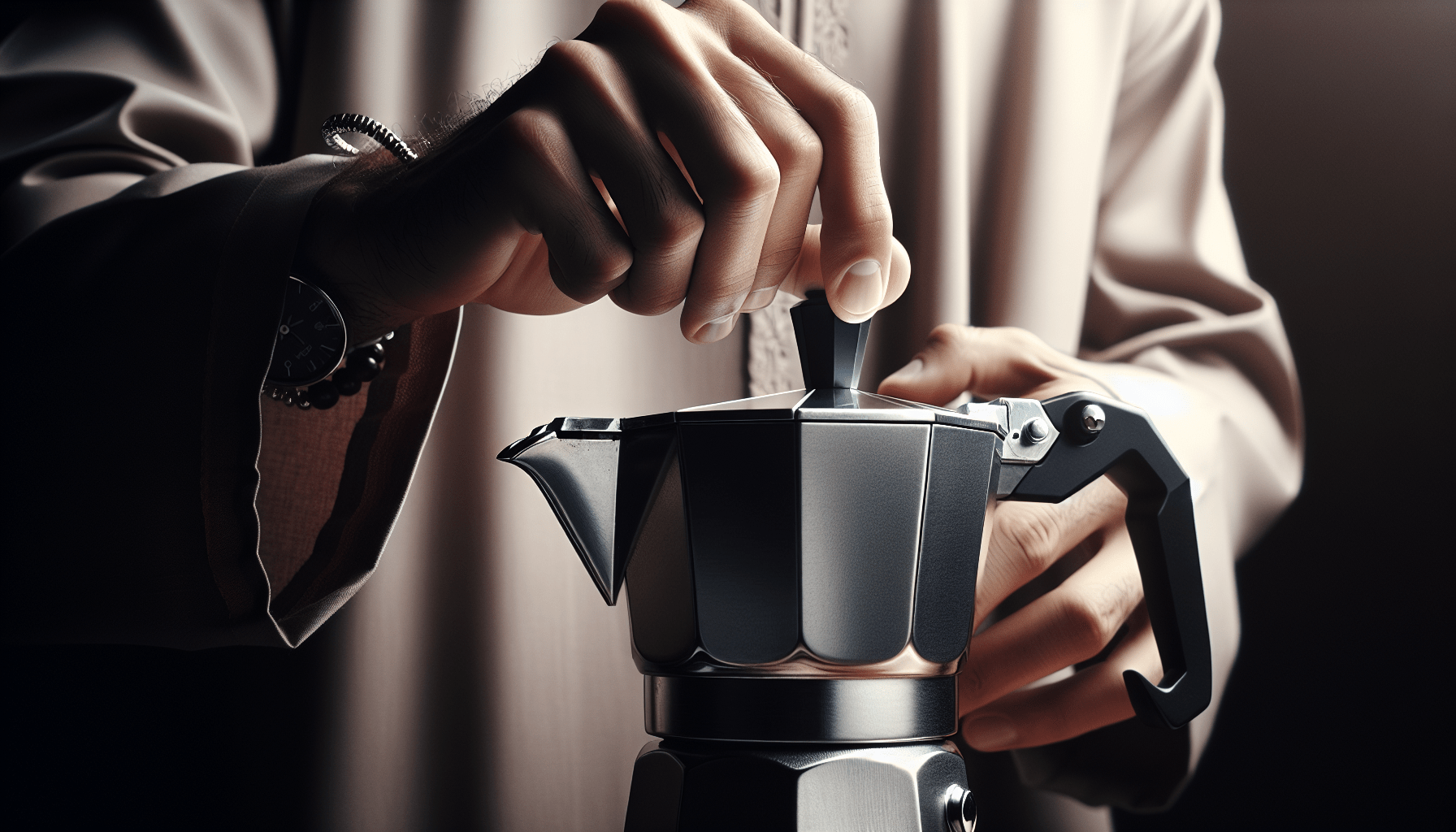Have you ever wondered how the brewing process differs from electric espresso machines? While both methods aim to create a delicious cup of espresso, they employ distinct techniques to achieve their desired results. Understanding these differences can help you appreciate the unique characteristics and flavors that each method brings to your morning cup of joe. So, grab your favorite mug and let’s dive into the fascinating world of espresso brewing.
Types of Brewing Processes
Drip Brewing
Drip brewing is one of the most common methods of making coffee, and it is often used in households and offices. In this process, water is poured into a reservoir and heated to a temperature of around 195 to 205°F (90 to 96°C). The hot water then drips through a filter containing ground coffee, extracting flavor and aroma as it passes through. The brewed coffee collects in a carafe or mug below the filter. Drip brewing is known for producing a clean and smooth cup of coffee.
French Press Brewing
French press brewing, also known as plunger or press pot brewing, is a popular method for those who prefer a stronger and fuller-bodied coffee. To prepare coffee with a French press, coarsely ground coffee is placed in the bottom of the carafe. Hot water is then poured over the coffee grounds, and after a few minutes of steeping, a plunger with a mesh filter is pressed down to separate the coffee grounds from the brewed coffee. The result is a rich and robust cup of coffee with a fuller mouthfeel.
Pour Over Brewing
Pour over brewing is a manual brewing method that involves pouring hot water over a bed of coffee grounds in a dripper or pour over cone. The water gradually seeps through the grounds, extracting flavor as it passes. This method allows for more control over the brewing process, as the person brewing can adjust factors such as water flow rate and pour pattern to achieve their desired flavor profile. Pour over brewing often produces a clean and bright cup of coffee with a crisp acidity.
Aeropress Brewing
The Aeropress is a versatile and compact brewing device that combines elements of immersion and pressure brewing. To use an Aeropress, a paper filter is placed in the brewing chamber, and coffee grounds are added. Hot water is then poured over the grounds, and the mixture is stirred before being plunged through the filter. The pressure created during plunging extracts flavors quickly, resulting in a smooth and clean cup of coffee. The Aeropress allows for experimentation with different brewing techniques, making it a favorite among coffee enthusiasts.
Cold Brew
Cold brew is a unique brewing method that involves steeping coffee grounds in cold water for an extended period, usually 12 to 24 hours. The slow extraction process at a lower temperature creates a smoother and less acidic cup of coffee compared to other brewing methods. Cold brew is often favored for its mellow and easy-drinking flavor profile. It can be enjoyed over ice or mixed with milk to create delightful iced coffees or lattes.
How Electric Espresso Machines Work
Overview of Electric Espresso Machines
Electric espresso machines are specialized appliances designed to produce a concentrated and flavorful coffee known as espresso. These machines automate the process of brewing espresso, making it convenient for home and commercial use. Electric espresso machines typically consist of a water reservoir, a pump system, a boiler, and a portafilter.
Pump System
The pump system in an electric espresso machine plays a crucial role in creating the pressure needed for extracting espresso. The pump moves water from the reservoir into the boiler, generating pressure between 8 to 12 bars (116 to 174 psi). This high pressure ensures optimal extraction of flavors and oils from the coffee grounds, resulting in the characteristic espresso taste.
Boiler
The boiler in an electric espresso machine heats and maintains the water temperature needed for brewing espresso. It has a thermostat that regulates the temperature, typically set between 195 to 205°F (90 to 96°C). The boiler can be made of stainless steel or brass, both of which efficiently distribute heat to ensure stable and consistent brewing temperatures.
Portafilter
The portafilter is a detachable handle with a metal filter basket where coffee grounds are placed. It attaches to the brewing group, which is connected to the boiler and pump system. The portafilter is responsible for holding the coffee grounds during the extraction process and distributing the pressurized water evenly over the grounds. It also allows for easy removal of the spent coffee grounds after brewing.
Grinding and Tamping
To prepare espresso, coffee grounds need to be finely and uniformly ground. Electric espresso machines often have built-in grinders that allow users to adjust the grind size according to their preference. The consistency and size of the grind greatly impact the extraction process and the resulting flavor. After grinding, the coffee grounds are carefully tamped down into the portafilter using a tamper, ensuring even distribution and compactness.
Extraction Process
The extraction process in electric espresso machines involves pumping hot pressurized water through the tightly packed coffee grounds in the portafilter. The water passes through the coffee, dissolving and extracting the soluble compounds. The pressure and flow rate of the water determine the extraction time and ultimately the flavor profile of the espresso. Proper extraction results in a balanced and complex espresso shot with a layer of foam called crema on top.
Water Temperature and Pressure
Brewing Temperature in Different Processes
Drip brewing typically requires water temperatures between 195 to 205°F (90 to 96°C) to achieve optimum extraction. French press brewing also benefits from water temperatures within this range to release the flavors and oils from the coffee grounds effectively. Pour over brewing allows for more precise control over brewing temperature, with some coffee enthusiasts preferring temperatures slightly lower, around 185 to 195°F (85 to 90°C), to highlight specific flavor notes. Cold brew, on the other hand, is brewed using cold or room temperature water, eliminating the need for heat altogether.
Pressure in Electric Espresso Machines
Electric espresso machines generate high pressure between 8 to 12 bars (116 to 174 psi). This pressure is crucial for extracting the rich flavors and oils from the finely ground coffee in a short amount of time. The high pressure forces the water through the coffee grounds, resulting in the concentrated and intense flavor profile characteristic of espresso.
Pressure in Other Brewing Processes
While electric espresso machines rely heavily on pressure, other brewing processes such as drip brewing, French press, pour over, and cold brew do not require the same level of pressure to achieve satisfactory results. These methods rely more on the infusion and extraction time to extract flavors from the coffee grounds.
Grind Size and Consistency
Importance of Grind Size
Grind size plays a vital role in the brewing process, as it determines the surface area of the coffee exposed to the water during extraction. Finer grinds have more surface area, resulting in faster and more intense extraction, while coarser grinds have less surface area, leading to slower extraction and a less concentrated flavor.
Grind Size for Electric Espresso Machines
Electric espresso machines require a fine and consistent grind size for optimal extraction. The fine grind allows for more efficient extraction of flavors and oils, while the consistency ensures even water flow through the coffee grounds. Espresso typically requires a grind size similar to table salt to achieve the desired extraction within the short brewing time.
Grind Size for Other Brewing Processes
Other brewing processes have varying grind size requirements based on factors such as immersion time and water flow rate. Drip brewing generally requires a medium grind to balance extraction speed and flavor, while French press benefits from a coarse grind to prevent overextraction. Pour over brewing typically calls for a medium-fine grind to allow for precise control over extraction, and cold brew utilizes a coarse grind to accommodate the extended steeping time.
Consistency in Grind Size
Consistency in grind size is crucial for achieving an evenly extracted brew and consistent flavor. Electric espresso machines often have built-in grinders or recommend using a quality burr grinder to ensure uniformity in grind size. In other brewing processes, using a burr grinder or purchasing pre-ground coffee from reputable sources can help maintain consistent results.
Brewing Time
Average Brewing Time for Electric Espresso Machines
Electric espresso machines are designed to brew a shot of espresso within 25 to 30 seconds. This short brewing time is necessary to extract flavors quickly and prevent overextraction, which can result in a bitter taste. The powerful pump system in electric espresso machines allows for the rapid delivery of pressurized hot water, ensuring efficient extraction within the desired time frame.
Brewing Time for Other Brewing Processes
Other brewing processes typically have longer brewing times compared to electric espresso machines. Drip brewing can take anywhere from 4 to 8 minutes, depending on factors such as water flow rate and the desired strength of the coffee. French press brewing generally requires steeping time between 4 to 6 minutes, allowing for a more thorough extraction. Pour over brewing can range from 2 to 4 minutes, depending on factors like grind size and water flow rate. Cold brew, being a slow extraction method, requires a steeping time of 12 to 24 hours.
Factors Affecting Brewing Time
Several factors can impact brewing time across different methods. Water temperature, grind size, water-to-coffee ratio, and infusion time all have an influence on how quickly or slowly flavors are extracted. Adjusting these variables allows for customization and the achievement of desired flavor profiles.
Extraction Rate
Definition of Extraction Rate
Extraction rate refers to the percentage of soluble compounds extracted from the coffee grounds during the brewing process. It is an essential factor in determining the strength, flavor, and balance of the brew. A well-extracted coffee results in a harmonious combination of sweetness, acidity, and bitterness.
Extraction Rate in Electric Espresso Machines
Electric espresso machines excel in achieving high extraction rates due to their high pressure and fast brewing time. The pressurized water extracts a significant portion of the soluble compounds in a short amount of time, resulting in a concentrated and robust espresso shot. The extraction rate can be adjusted to match personal preferences and the specific characteristics of the coffee beans used.
Extraction Rate in Other Brewing Processes
Extraction rates in other brewing processes may vary depending on the method and variables involved. Drip brewing often aims for a balanced extraction rate, ensuring the extraction of desirable flavors without overextracting bitter compounds. French press brewing tends to have higher extraction rates due to the longer steeping time and immersion of coffee grounds. Pour over brewing allows for greater control over extraction rate, allowing users to adjust variables to achieve their desired strength and flavor. Cold brew, with its extended steeping time, is known for extracting a high percentage of soluble compounds, resulting in a smooth and naturally sweet cup of coffee.
Impact of Extraction Rate on Flavor
The extraction rate greatly influences the flavor profile of the brewed coffee. Underextraction, where not enough soluble compounds are extracted, can result in a weak and sour taste. Overextraction, on the other hand, leads to a bitter and unpleasant flavor. Achieving the right balance in extraction rate is vital to unlocking the desired flavors and aroma present in the coffee beans used.
Flavor Profile and Strength
Flavor Profile in Electric Espresso Machines
Electric espresso machines offer a wide range of flavor profiles depending on the beans used, the roast level, and the extraction variables. Espresso shots can showcase a rich and complex flavor profile, encompassing notes of chocolate, caramel, fruitiness, or even floral and herbal undertones. The strength of the espresso shot can be adjusted by modifying variables such as grind size, extraction time, and water-to-coffee ratio.
Flavor Profile in Other Brewing Processes
Other brewing processes also contribute to unique flavor profiles. Drip brewing can produce a clean and well-balanced cup with varying degrees of acidity and sweetness, depending on the coffee beans used. French press brewing often provides a full-bodied and bold cup of coffee with a more pronounced mouthfeel. Pour over brewing allows for the highlighting of specific flavor notes, resulting in a precisely nuanced and vibrant cup. Cold brew, with its low-acidity and smoothness, offers a mellow flavor profile that emphasizes the natural sweetness of the coffee beans.
Strength of the Brew
Strength refers to the intensity of the coffee’s flavor and how pronounced it is on the palate. Electric espresso machines allow for a concentrated and robust espresso shot with a higher strength compared to other brewing methods. Drip brewing, French press, pour over, and cold brew can all be adjusted in strength through variables such as coffee-to-water ratio and infusion time.
Balancing Flavor and Strength
Finding the right balance between flavor and strength is a matter of personal preference. Electric espresso machines allow for customization in terms of grind size, extraction time, and water-to-coffee ratio, allowing users to tailor the flavor and strength to their liking. Other brewing processes offer similar flexibility, empowering coffee enthusiasts to experiment and discover their desired balance between flavor and strength.
Crema Formation
Crema in Electric Espresso Machines
Crema is a layer of foam that forms on top of properly brewed espresso shots. It is created when carbon dioxide, oils, and soluble compounds in the coffee emulsify under high pressure. Electric espresso machines are known for their ability to generate the necessary pressure to produce a rich and creamy crema. The crema adds texture and enhances the visual appeal of the espresso, often characterized by its caramel color and persistence.
Crema in Other Brewing Processes
Other brewing processes, such as drip brewing, French press, pour over, and cold brew, do not typically produce a crema due to the absence of high pressure. While these methods may not have a visible crema layer, they can still deliver flavorful and enjoyable cups of coffee. The focus in these brewing processes lies more on achieving the desired flavor profile and strength rather than crema formation.
Factors Affecting Crema Formation
Crema formation in electric espresso machines can be influenced by several factors, including coffee freshness, grind size, tamping pressure, and the quality and roast level of the coffee beans used. The carbon dioxide content in freshly roasted coffee beans plays a significant role in crema formation. Proper distribution of the coffee grounds in the portafilter and an evenly tamped bed of coffee also contribute to crema quality and consistency.
Ease of Use
Convenience of Electric Espresso Machines
Electric espresso machines offer convenience and ease of use, making them popular among coffee lovers. The automated processes of water heating, pumping, and extraction simplify the brewing process, allowing users to create espresso shots at the touch of a button. These machines often feature programmable settings and intuitive controls, making it effortless for users to customize their brew according to their preferences.
Simplicity of Other Brewing Processes
Other brewing processes also have their own simplicity and charm. Drip brewing typically involves a straightforward setup of adding water and coffee grounds, and the machine takes care of the rest. French press brewing requires a relatively simple process of adding coffee grounds, water, and conducting a few plunges. Pour over brewing may have a steeper learning curve, but once mastered, it offers control and simplicity. Cold brew involves steeping coffee grounds and water in a container, requiring minimal effort during the brewing process.
Maintenance and Cleanup
Electric espresso machines often require more maintenance and cleanup compared to other brewing methods due to their complexity. Regular cleaning and descaling of the machine, as well as proper care of the portafilter and other components, are essential for optimal performance and longevity. Other brewing processes typically involve simple cleaning of the equipment and occasional descaling, making them relatively easier to maintain.
Flexibility and Versatility
Brewing Options with Electric Espresso Machines
Electric espresso machines offer versatility in terms of brewing options. They allow users to create not only traditional espresso shots but also various espresso-based beverages such as cappuccinos, lattes, and macchiatos. The steam wand feature in some espresso machines enables milk frothing, expanding the range of drinks that can be prepared.
Experimentation with Other Brewing Processes
Other brewing processes provide coffee enthusiasts with a wide range of experimentation opportunities. With drip brewing, French press, pour over, and cold brew, different variables such as coffee-to-water ratio, infusion time, water temperature, and grind size can be adjusted to achieve unique flavor profiles. These methods encourage creativity and personalization in brewing, allowing individuals to explore and discover their preferred coffee experiences.
Adapting to Different Coffee Beans
Electric espresso machines offer the flexibility to adapt to different coffee beans and roast levels. By adjusting variables such as grind size, extraction time, and water-to-coffee ratio, users can explore the potential flavors and characteristics of various coffee beans. Other brewing processes also allow for the appreciation of different coffee beans, offering a wide variety of flavor profiles that can be further highlighted or nuanced through brewing techniques and variables.
In conclusion, the brewing process differs significantly from electric espresso machines. Various brewing processes, such as drip brewing, French press, pour over, aeropress, and cold brew, offer distinct flavor profiles and brewing characteristics. Electric espresso machines automate the brewing process, utilizing high pressure and extraction speed to produce concentrated and robust espresso shots with a creamy crema. Grind size, brewing time, water temperature, and extraction rate are crucial factors that contribute to the overall flavor and strength of the brew. Moreover, the simplicity and flexibility of other brewing processes, along with the convenience and versatility of electric espresso machines, cater to different preferences and exploration opportunities in the world of coffee.




